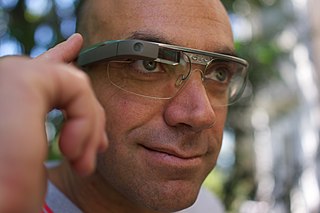
Virtual reality (VR) is a simulated experience that employs pose tracking and 3D near-eye displays to give the user an immersive feel of a virtual world. Applications of virtual reality include entertainment, education and business. Other distinct types of VR-style technology include augmented reality and mixed reality, sometimes referred to as extended reality or XR, although definitions are currently changing due to the nascence of the industry.

Mixed reality (MR) is a term used to describe the merging of a real-world environment and a computer-generated one. Physical and virtual objects may co-exist in mixed reality environments and interact in real time.

Flipkart Private Limited is an Indian e-commerce company, headquartered in Bangalore, and incorporated in Singapore as a private limited company. The company initially focused on online book sales before expanding into other product categories such as consumer electronics, fashion, home essentials, groceries, and lifestyle products.

Leap Motion, Inc. was an American company that manufactured and marketed a computer hardware sensor device that supports hand and finger motions as input, analogous to a mouse, but requires no hand contact or touching. In 2016, the company released new software designed for hand tracking in virtual reality. The company was sold to the British company Ultrahaptics in 2019, which rebranded the two companies under the new name Ultraleap.

Sketchfab is a 3D modeling platform website to publish, share, discover, buy and sell 3D, VR and AR content. It provides a viewer based on the WebGL and WebXR technologies that allows users to display 3D models on the web, to be viewed on any mobile browser, desktop browser or Virtual Reality headset.

An optical head-mounted display (OHMD) is a wearable device that has the capability of reflecting projected images as well as allowing the user to see through it. In some cases, this may qualify as augmented reality (AR) technology. OHMD technology has existed since 1997 in various forms, but despite a number of attempts from industry, has yet to have had major commercial success.

Smartglasses or smart glasses are eye or head-worn wearable computers that offer useful capabilities to the user. Many smartglasses include displays that add information alongside or to what the wearer sees. Alternatively, smartglasses are sometimes defined as glasses that are able to change their optical properties, such as smart sunglasses that are programmed to change tint by electronic means. Alternatively, smartglasses are sometimes defined as glasses that include headphone functionality.

Reality Labs is a business and research unit of Meta Platforms that produces virtual reality (VR) and augmented reality (AR) hardware and software, including virtual reality headsets such as Quest, and online platforms such as Horizon Worlds. In June 2022, several artificial intelligence (AI) initiatives that were previously a part of Meta AI were transitioned to Reality Labs. This also includes Meta's fundamental AI Research laboratory FAIR which is now part of the Reality Labs - Research (RLR) division.

Meta was a company that designed augmented reality products. The company was founded by Meron Gribetz in 2012, based on the "Extramissive spatial imaging digital eye glass" technology invented by Gribetz and Mann originally filed with the US Patent and Trademark office Jan 3, 2013.

Windows Mixed Reality (WMR) is a discontinued platform by Microsoft which provides augmented reality and virtual reality experiences with compatible head-mounted displays.
Rony Abovitz is an American entrepreneur. Abovitz founded MAKO Surgical Corp., a company manufacturing surgical robotic arm assistance platforms, in 2004. MAKO was acquired by Stryker Corporation in 2013 for $1.65B.
uSens, Inc. is a Silicon Valley startup founded in 2014 in San Jose, California. The company's core team includes researchers and developers who builds interactive and immersive computer-vision tracking solutions. The uSens team has extensive experience in artificial intelligence (AI), computer vision, 3D Human–computer interaction (HCI) technology and augmented reality and virtual reality. uSens has been applying computer vision and AI technologies in AR/VR, Automotive and smartphones.

Brendan Trexler Iribe is an American game programmer, entrepreneur and the original CEO and co-founder of Oculus VR, Inc. and Scaleform. He is the managing partner at BIG Ventures, an early-stage venture fund.
DAQRI was an American augmented reality company headquartered in Los Angeles, CA.

Peggy Johnson is most recently the former chief executive officer (CEO) of Magic Leap, succeeding Rony Abovitz in Sept 2020. Before joining Magic Leap, she held the position of Executive Vice President of Business Development at Microsoft. Johnson was replaced as CEO by Ross Rosenberg in November 2023.

Meron Gribetz is an Israeli technology entrepreneur. He was the founder and CEO of Meta, a Silicon Valley technology company that produced augmented reality products, closed in 2019. He was a founder of Inner Cosmos, makers of a digital pill designed to re-balance brain networks, and continued as CEO As of 2023.

Within Unlimited, Inc, or commonly Within, is a studio based in Los Angeles developing the VR fitness service Supernatural on the Meta Quest. The company was founded by Chris Milk and Aaron Koblin in 2014 and initially created, acquired, and distributed 360-degree video, AR, and VR experiences across web, mobile, console, and headsets. The company was acquired by Meta Platforms, Inc., in February 2023.

CGTrader is a 3D model marketplace for VR/AR and CG projects, and professional 3D designer community. It was founded in 2011 and is headquartered in Vilnius, Lithuania. CGTrader has attracted funding from Practica Capital, a seed and venture fund based in Vilnius, as well as from Intel Capital.
GoMeta is an American software company headquartered in San Diego. The company was founded by Dmitry Shapiro, Sean Thielen, and Jonathan Miller in September 2016. GoMeta's Koji platform lets non-technical individuals create and publish mini apps, progressive web applications that run on all devices and operating systems, and embed inside of social networks and messengers.
Varjo Technologies Oy, commonly referred to as Varjo, is a Finnish manufacturer of virtual reality, augmented reality and mixed reality headsets. The company was founded in 2016 by former Nokia and Microsoft executives. Varjo specializes in developing high-resolution devices that offer clarity comparable to the human eye.















